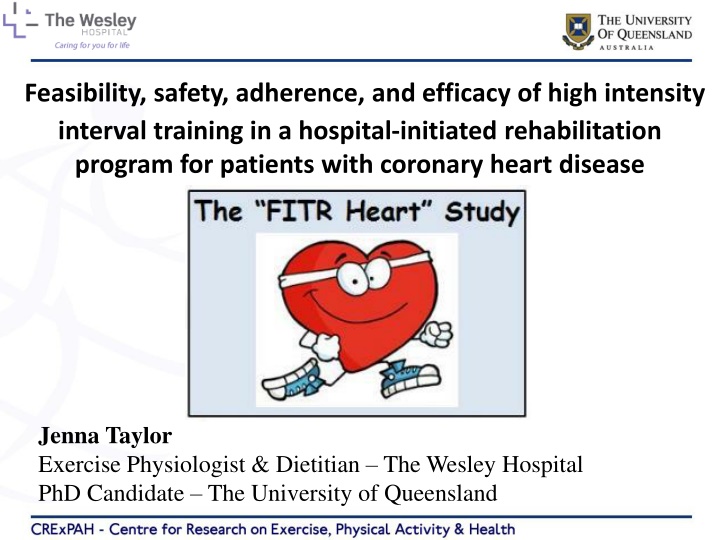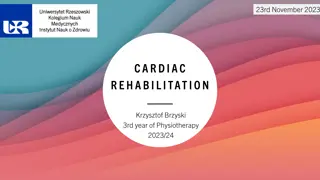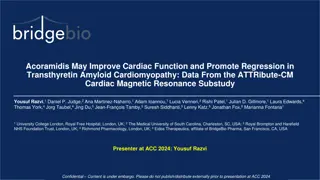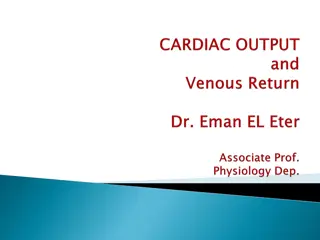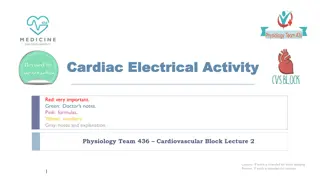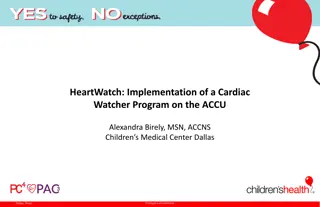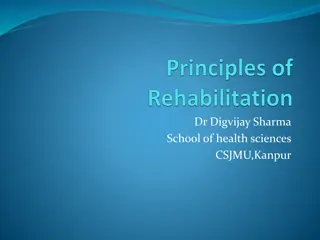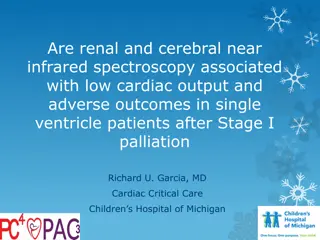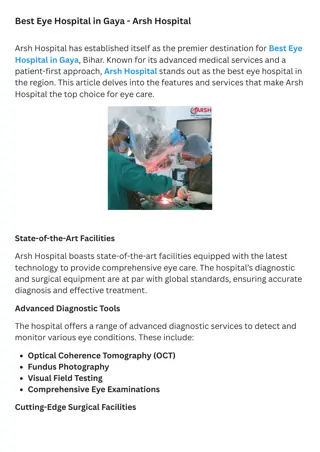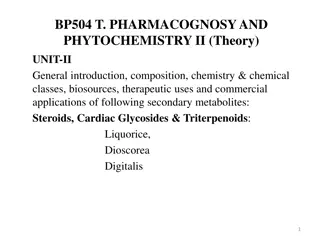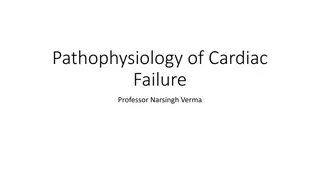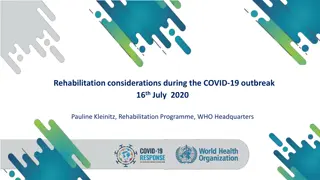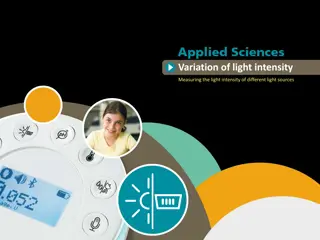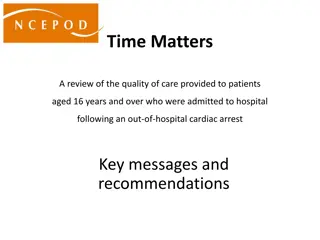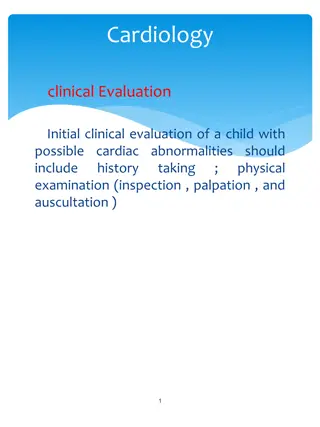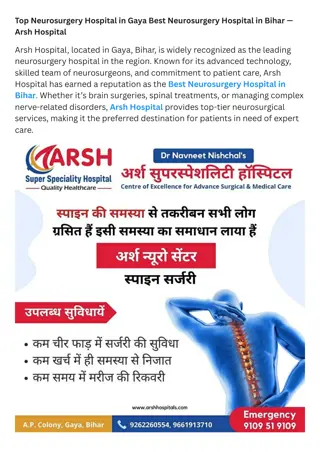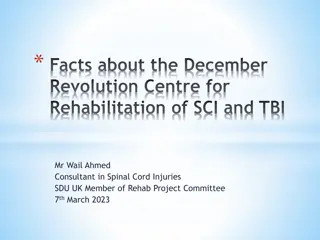High Intensity Interval Training in Hospital-Based Cardiac Rehabilitation
This study examines the feasibility, safety, adherence, and efficacy of implementing High Intensity Interval Training (HIIT) in a hospital-initiated rehabilitation program for patients with coronary heart disease. It compares HIIT with Moderate Intensity Continuous Training (MICT) in terms of cardiorespiratory fitness (VO2peak) and other outcomes after a 4-week intervention, shedding light on the potential benefits for patients with Coronary Artery Disease (CAD) undergoing cardiac rehabilitation.
Download Presentation

Please find below an Image/Link to download the presentation.
The content on the website is provided AS IS for your information and personal use only. It may not be sold, licensed, or shared on other websites without obtaining consent from the author.If you encounter any issues during the download, it is possible that the publisher has removed the file from their server.
You are allowed to download the files provided on this website for personal or commercial use, subject to the condition that they are used lawfully. All files are the property of their respective owners.
The content on the website is provided AS IS for your information and personal use only. It may not be sold, licensed, or shared on other websites without obtaining consent from the author.
E N D
Presentation Transcript
Feasibility, safety, adherence, and efficacy of high intensity interval training in a hospital-initiated rehabilitation program for patients with coronary heart disease Jenna Taylor Exercise Physiologist & Dietitian The Wesley Hospital PhD Candidate The University of Queensland
Cardiorespiratory Fitness and Survival VO2 = > 22ml/kg/min VO2 = 15-22ml/kg/min VO2 = < 15ml/kg/min For every 1ml/kg/min increase in fitness, survival improved by 9% Kavanagh, T., et al., Prediction of long-term prognosis in 12 169 men referred for cardiac rehabilitation. Circulation, 2002. 106(6): p. 666.
High intensity Interval Training (HIIT) increased cardiorespiratory fitness compared to moderate intensity continuous training (MICT) 6ml/kg/min 2.7ml/kg/min
HIIT increases VO2peak by 19.4% compared to moderate intensity 10.9% Equivalent to ~ 10-20% reduction in risk of death over 8 years Weston, Wisloff and Coombes, British Journal of Sports Medicine, Published Online First: [ 23 Oct, 2013]
RATIONALE RELEVANCE TO REAL WORLD Maximal exercise testing not routinely conducted No Peak HR data Cardiac medications can affect HR
AIM To compare High Intensity Interval Training (HIIT) with Moderate Intensity Continuous Training (MICT) in patients with Coronary Artery Disease (CAD) completing a hospital-based cardiac rehabilitation program, using subjective measures of exercise intensity: Primary outcome = cardiorespiratory fitness (VO2peak) after 4 weeks Secondary outcomes = feasibility, safety, and exercise adherence
METHODS The FITR Heart Study Single centre randomised controlled trial (The Wesley Hospital) HIIT (intervention) vs MICT (usual care) Stage Timeframe Weekly Exercise Training Level of support 1 month Hospital Cardiac Rehab Program = 2 x supervised sessions + 1 home-based session Supervised exercise classes Stage 1 2 months Home-based Program > 3 x home-based sessions Routine support Stage 2 Maintenance Program > 3 x home-based sessions 9 months No routine support Stage 3
METHODS Recruited patients with angiographically proven coronary artery disease Commencing hospital-based cardiac rehabilitation Recruitment Includes MI, Stent, CABG, Medical Main exclusion criteria = ASCM s Contraindications to Maximal Exercise Testing
METHODS EFFICACY Cardiorespiratory Fitness (VO2peak) Baseline Testing
METHODS MICT HIIT 3 sessions per week (2 supervised + 1 home-based) Frequency 3min RPE < 11 1 min RPE 11-13 Warm-up 3min RPE < 11 4 x 4 min high intensity intervals at RPE 15-18 interspersed with 3min recovery at RPE 11-13 Exercise 34min moderate intensity at RPE 11- 13 Exercise Intensity Training 3min RPE < 11 Warm-down 3min RPE < 11 Duration 40 minutes 32 minutes RPE = Rating of Perceived Exertion
HIIT Protocol HIIT Protocol 4 x 4 minutes at RPE 15 4 x 4 minutes at RPE 15- -18 (Hard to Very Hard) Various exercise machines 18 (Hard to Very Hard) 4:00 4:00 4:00 4:00 3:00 3:00 3:00 4:00 3:00 Warm up Cool down 3 minute active recovery at RPE 11 3 minute active recovery at RPE 11- -13 (Fairly light to Somewhat hard) (Fairly light to Somewhat hard) 32 mins/session 13
METHODS FEASIBILITY Participants and Staff Questionnaires for quantitative + qualitative data SAFETY Type, incidence and severity of adverse events. Grade 1: Mild; Grade 2: Moderate; Grade 3: Severe; Grade 4: Life-threatening; and Grade 5: Death Follow-Up EXERCISE ADHERENCE Testing Measured as: 1. Completion of exercise sessions 2. Ability to achieve prescribed intensity & duration Measured from Supervised exercise records Self-report weekly exercise training records
METHODS TIME POINTS 5 Weeks 13 Weeks 6 Months 12 Months Follow-Up Testing STATISTICAL ANALYSIS One-way ANCOVA Independent Samples Kruskal-Wallis Test Independent Sample T-Test
RESULTS Inclusion/Exclusion Referred to Cardiac Rehab N = 406 Patients with no CAD (i.e. valve or PPM only) N = 116 Patients with CAD Approached N = 290 Patients Declined N = 178 Patients Excluded N = 16 Reasons included: No significant CAD Severe pulmonary disease (n=1) Orthopaedic limitation (n=1) Planned operation (n=1) New PPM insertion (n = 2) CKD < stage 3 (n=2) Unstable arrhythmia (n=2) Embolism risk (n=2) Cardiologist declined (n=3) Participants Recruited N = 96 Participants Excluded for positive stress test N = 3 Participants Randomised N = 93
RESULTS Baseline Participant Characteristics HIIT (n= 47) MICT (n= 46) p value Age (years) 65 + 7 65 + 8 >0.05 VO2peak (ml/kg/min) BMI (kg/m2) 27.7 + 6.0 27.4 + 7.3 >0.05 28.0 + 4.0 29.0 + 4.0 >0.05 Males 39 39 >0.05 Females 7 8 >0.05 Cardiac event / intervention (n) CABG 15 10 >0.05 PCI/Stent 23 24 >0.05 Medical 8 13 >0.05 Acute coronary syndrome 9 14 >0.05 Other risk factors (n) Diabetes 2 7 >0.05 Smoking 1 2 >0.05
RESULTS Baseline Medications HIIT (%) MICT (%) p value 40 41 >0.05 B-Adrenergic blockers 98 93 >0.05 Statins 19 37 >0.05 ACE inhibitor 34 35 >0.05 Angiotensin II receptor blockers Calcium channel blockers 4 15 >0.05 Antiplatelet agents 96 91 >0.05 Aspirin 53 59 >0.05 Other
RESULTS 5 weeks Cardiorespiratory Fitness (VO2Peak) 35 34 Group p = 0.012 33 HIIT (n=43) VO2 ml/kg/min 32 Group p = >0.05 31 MICT (n=43) 30 29 2.9 28 1.1 27 26 Baseline Week 5 HIIT = +2.9 + 3.5 ml/kg/min; MICT = 1.1 + 0.0 ml/kg/min
RESULTS Feasibility (Participants) HIIT (n=43) MICT (n=43) Feelings about Exercise Protocol 10 Group p = 0.412 Group p = 0.335 Group p = 0.032 Group p = 0.933 9 Score on 7-Point Likert Scale 8 7 6 5 4 3 2 1 0 Confidence in Exercise Protocol Ease of Instructions Ability to Manage Intensity Enjoyment of Exercise Statistical Test = Non-Parametric Independent Samples Kruskal-Wallis Test
RESULTS Feasibility (Staff) HIIT (n=43) MICT (n=43) 8 Comparison of Exercise Protocol 7 Group p = 0.147 Group p = 0.382 Group p = 0.336 Group p = 0.562 6 Score on 5-Point Likert Scale 5 4 3 2 1 0 Confidence in delivery of protocol Patient acceptance of protocol Patient's ability to manage intensity Work associated with monitoring Statistical Test = Non-Parametric Independent Samples Kruskal-Wallis Test
RESULTS Feasibility (Staff) Feasibility of HIIT Number of Staff Is HIIT feasible (n=6): Definitely feasible 4 Some-what feasible 2 Not feasible 0
RESULTS Safety Serious Adverse Events life-threatening OR requiring hospitalisation None related to exercise intervention Mild or moderate symptoms with exercise Reported symptoms Severity HIIT (n) MICT (n) Fatigue Grade 2 Moderate 2 3 Soreness (muscle/joint/feet) Grade 2 Moderate 5 3 Shortness of breath Grade 2 Moderate 1 1 Angina pain (chest/throat) Grade 2 Moderate 1 2 Feeling light-headed Grade 2 Moderate 3 2 Total 12 11
RESULTS Exercise Adherence Adherence to intensity & duration HIIT (n=43) MICT (n=43) p value Adherence to exercise protocol 84 + 19 90 + 19 0.094 Average Training RPE 16 + 1 12 + 1 0.000 Peak Training RPE 17 + 2 13 + 1 0.000 Average Training %HRpeak 90 + 7 74 + 8 0.000 Peak Training %HRpeak 95 + 7 77 + 8 0.000 Statistical Test = Independent Sample T Test
RESULTS Exercise Adherence Completion of exercise sessions HIIT (n=43) MICT (n=43) p value Completion of sessions (%) 91 + 14 90 + 19 0.918 Average sessions per week 3 + 1 4 + 2 0.010 Total exercise minutes per week 125 + 59 222 + 146 0.000 Statistical Test = Independent Sample T Test
SIGNIFICANCE / INNOVATION Our RPE-based HIIT protocol: Overcomes the limitations of HR-based HIIT protocols Allows for continual progression of workload Can be applied to various exercise modes (TM, bike, rower, cross-trainer) Can be implemented in cardiac rehab classes alongside MICT Allows for a broader range of exercise goals to be achieved Fosters independence with regards to managing exercise intensity
CONCLUSIONS HIIT improved cardiorespiratory fitness by almost 3-fold compared to MICT HIIT was equally feasible and safe compared to MICT Exercise adherence was high in both groups HIIT is more time efficient for improving fitness
FUTURE DIRECTIONS The FITR Heart Study - 12 Month Follow-Up Incorporate HIIT into Australian Cardiac Rehab Guidelines Offer guidance to clinicians around HIIT implementation
ACKNOWLEDGMENTS Wesley Hospital Cardiac Rehabilitation TEAM University of Queensland Dr David Holland, MBBS, PhD Dr Shelley Keating, PhD Dr Michael Leveritt, PhD Professor Jeff Coombes, PhD FUNDING Wesley Medical Research NHMRC Postgraduate Scholarship
Screening Process Absolute Exclusion Criteria < 4 weeks following ACS or CABG <3 weeks following PCI Obstructive left main artery disease Unstable angina Uncontrolled cardiac arrhythmia Acute endocarditis, myocarditis or pericarditis Moderate to severe aortic stenosis Decompensated heart failure Acute pulmonary embolism, or deep vein thrombosis Aortic dissection Higher degree heart block Hypertrophic obstructive cardiomyopathy Recent stroke or transient ischemic attack Uncontrolled diabetes Acute or chronic renal failure Pulmonary fibrosis or interstitial disease Severe neuropathy Angiographically proven CAD < 80 years old Screened by study medical advisor for eligibility Treating cardiologist informed of their patient s participation, with opportunity to exclude involvement Baseline maximal exercise test supervised by medical doctor.
RESULTS Cardiorespiratory Fitness (VO2Peak) 8 HIIT (n=43) 7 Change in VO2 ml/kg/min MICT (n=43) Group p = 0.029 6 Group p = 0.012 5 4 3 2.9 3.7 2 1 1.1 1.0 0 Week 5 Week 52 Mean + SE
RESULTS Drop-Out Reason for drop out HIIT (n) MICT (n) Adverse Event 1 1 Illness 1 1 Injury 1 0 Personal Reasons 1 1 Total 4 3
RESULTS Safety Serious Adverse Events life-threatening OR requiring hospitalisation Group Adverse Event Reason Relationship to Intervention Severity MICT Stroke Post-operative complication Not related Grade 4 Life-threatening HIIT Pericarditis Post-operative complication Not related Grade 4 Life-threatening HIIT Hypotensive episode (requiring CODE Blue) Recent increase to anti-hypertensive Possible exacerbation Grade 3 Severe / requiring hospitalisation MICT Atrial fibrillation (requiring hospital admission) Known history of PAF Not related Grade 3 Severe / requiring hospitalisation
RESULTS Feasibility (Staff) Ensure HIIT patients can complete exercises (i.e. stretches) post HIIT so that all patient's finish at the same time . Patients like to exceed their normal level of pushing themselves . [HIIT] Improves independence of some individuals and allows for a broader range of personal goals to be achieved. Not having maximal HR data makes initial exercise prescription more variable. I am looking forward to prescribing HIIT regularly in cardiac classes .
RESULTS Baseline Participant Characteristics HIIT (n= 47) MICT (n= 46) Age (years) 65 + 7 65 + 8 BMI (kg/m2) 28.0 + 4.0 29.0 + 4.0 VO2peak (ml/kg/min) 27.7 + 6.0 27.4 + 7.3 Peripheral SBP (mmHg) 128 + 15 129 + 14 Peripheral DBP (mmHg) 75 + 9 74 + 9 Pulse Wave Velocity (m/s) 8.3 + 1.5 8.6 + 1.6 Corrected Augmentation Index (%) 13 + 10 14 + 9.0 Resting Heart Rate (bpm) 56 + 10 56 + 8 Bodyweight (kg) 84.0 + 14.6 86.7 + 16.4 Waist Circumference (cm) 98.4 + 12.3 99.6 + 11.8 LDL-Cholesterol (mmol/L) 1.7 + 0.2 1.8 + 0.6 HOMA Insulin Resistance 2.7 + 1.8 3.2 + 2.2
RESULTS 5 weeks Outcome Measure HIIT + SD MICT + SD P value Pulse Wave Velocity (m/s) -0.4 + 0.9 -0.4 + 0.8 0.773 Augmentation Index (%) -1.0 + 7.0 -1.0 + 6.0 0.709 Resting Heart Rate (bpm) -3.0 + 6.0 -1.0 + 6.0 0.240 Bodyweight (kg) -0.4 + 1.4 -0.5 + 1.6 0.892 Waist Circumference (cm) -1.8 + 3.6 -1.4 + 2.6 0.611 LDL-Cholesterol (mmol/L) -0.1 + 0.3 0.0 + 0.9 0.782 HOMA Insulin Resistance -0.7 + 1.2 -0.4 + 1.7 0.578
